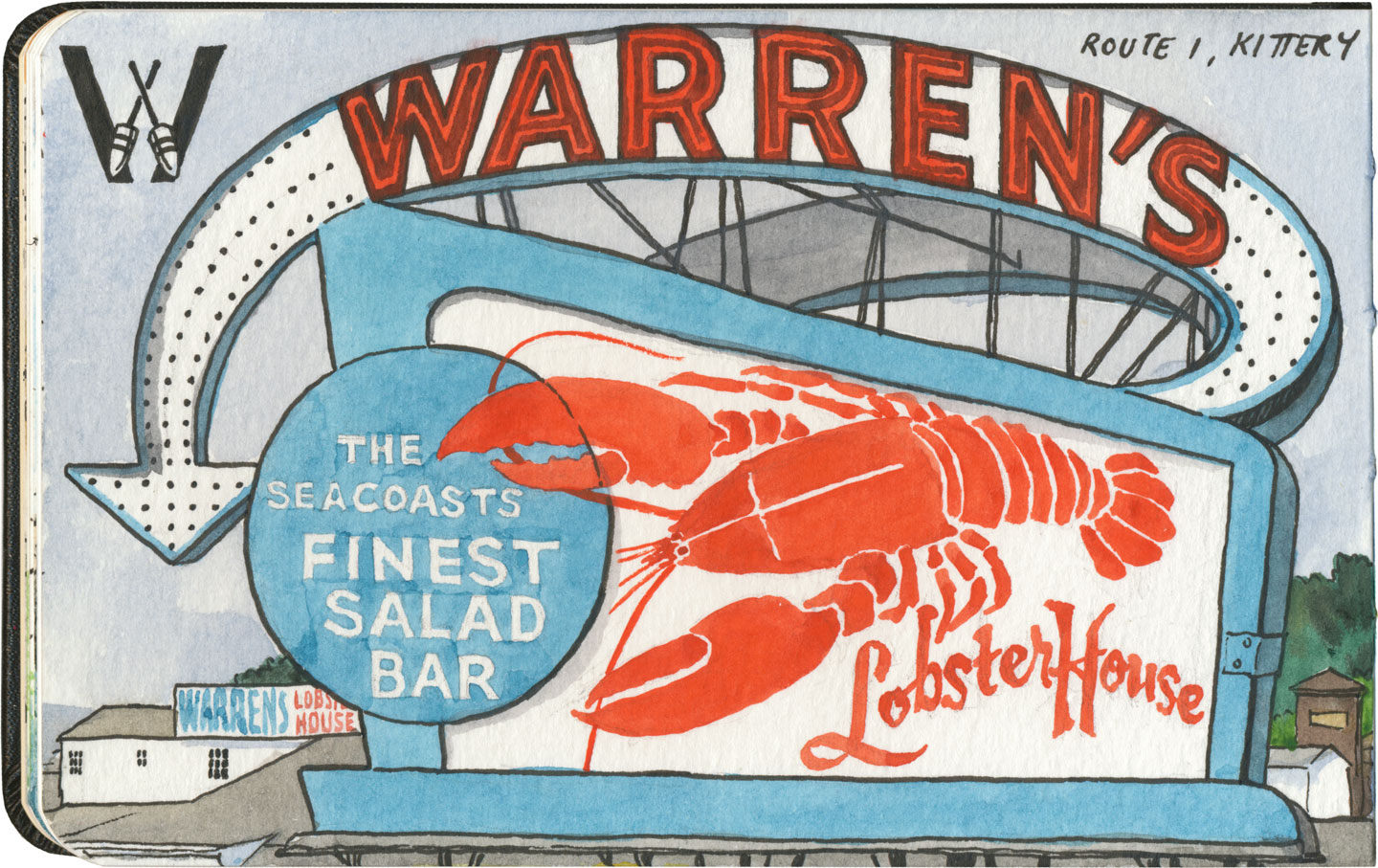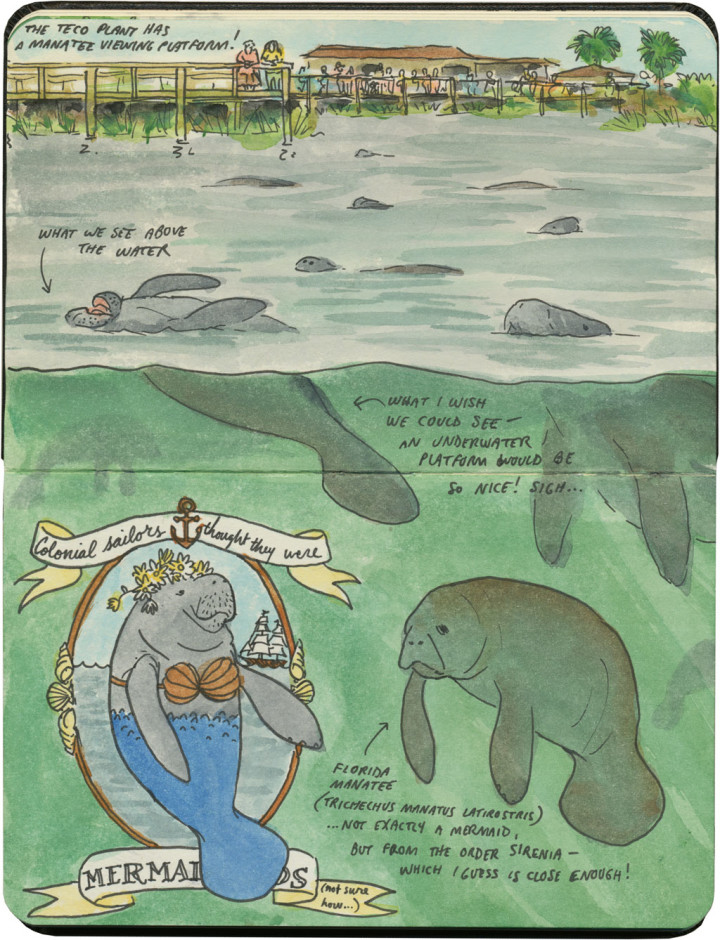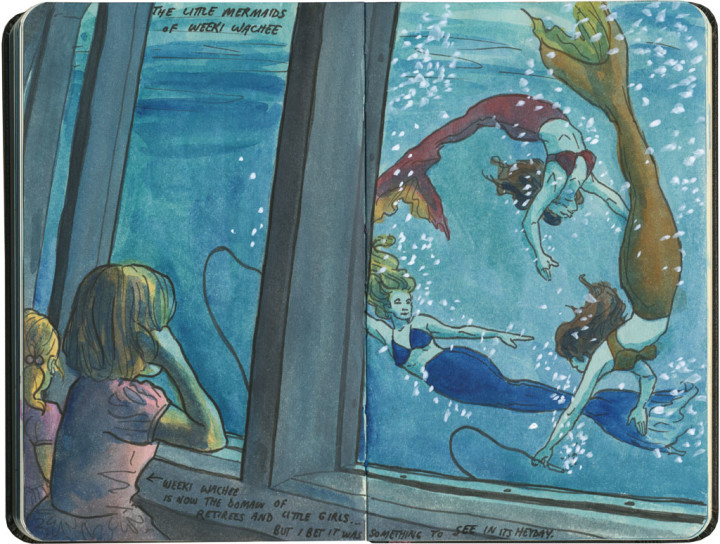
Tag Archives: east


Tile typography
New York might not have an ornate theatre marquee bearing its name, but it does boast a style of typography so iconic it’s practically synonymous with the city. I’m talking about the tile mosaics that grace many of the city’s subway stations.
I’ve racked up many months’ worth of visits to New York over the years, so you can imagine the amount of sketching I’ve done there. But the subway tile might just be my very favorite thing to draw in the whole city. Not only is it absolutely exquisite, but it’s also perfectly unique. Like the street tiles of New Orleans, all it takes is one glance, and you’ll know exactly where they’re from. Which, if you ask me, is where cities find their strength: the things that set them apart.
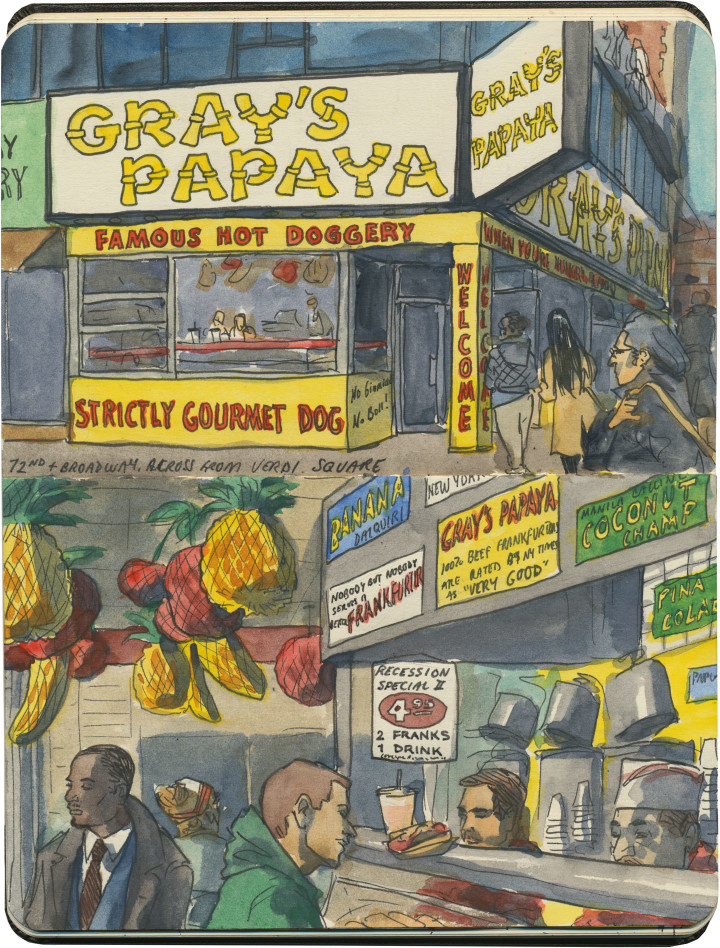
Why a papaya?
Chicago may be America’s hot dog capital, but leave it to New York to own the hot dog in the most unique way imaginable. Manhattan certainly holds its own when it comes to high concentration per capita of dawg dives, but what really interests me is New York’s history of washing their franks down with papaya juice. Yes, papayas and hot dogs are a thing—at least in Manhattan.
Well, the last time I was in town, I was determined to follow through on something I’d wanted to do for years: have a papaya showdown. So I dragged the Tailor and my two best native New Yorker friends with me for brunch dawgs in the dead of winter. (I have very patient friends.) We could have made a whole day of it, as there are many sausage-and-juice purveyors in the city, but I was mostly interested in comparing the two biggest and oldest rivals. (Besides, I wasn’t sure I could actually consume two hot dogs in succession, let alone a whole city’s worth.)
The first stop was Gray’s Papaya—this is the place most people think of when they think papayas (do people think papayas?). Open 24 hours a day at its original location at 72nd and Broadway, its cameo appearances in several films has made it something of a household name. The franks have a solidly dirty-water quality to them—order the “Recession Special” and add a swig of papaya juice to round out the experience. I have to say, though, that the kitsch factor here was surprisingly low. The crepe-paper fruit hanging from the ceiling was a nice touch, but that’s about where the fun stuff ended. Gray’s has been in that location for over forty years, but everything there was a low-rent version of slick and modern.
Papaya King, on the other hand, delivered on every front. The kitsch, the colors, the history, the design, even the food. Papaya juice, it turns out, is entirely too sweet for my taste, but the dogs were downright good. And best of all, Papaya King is the original, the real deal, the very first hot doggery to come up with the fruit-n-franks idea. The King has held court on the corner of E. 86th Street and Third Avenue since 1932, and the absolutely gorgeous neon pays homage to the original decor.
Papaya King has already won one hot dog war, when Nathan’s Famous opened a franchise next door in 1976, then capitulated when it lost the resulting price war. So as far as I’m concerned, it’s no surprise it came out on top this day, too. I am still no closer to understanding why someone would want papaya juice with their hotdog, but I’ll raise a bright yellow paper cup of the stuff to the King.

Lobsta lettering
As you already know, I’m a big fan of francophone lobsters. Well, just down the street from the world’s largest homard is this lobsta joint, complete with excellent French lettering.
Not to be outdone by its Canadian cousin, New England’s got some great lobster neon, as well. In Kittery, Maine, just across the Piscataqua from Portsmouth, NH (home of that other bit of vintage nautical neon), is one of my favorite sea-creature signs. But I have to admit, I took a bit of artistic license with this one: I happen to have an old menu from Warren’s and the design of that thing puts even its own sign to shame. So I replaced certain bits of the sketch with some of my favorite elements from the menu.
(I should get my Artistic License laminated and keep it in my wallet—because I’m not afraid to use it!)
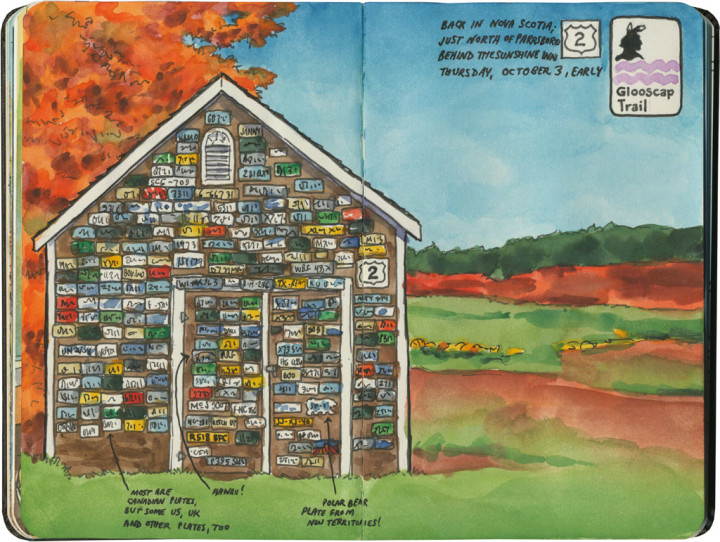
Tagging wall
Who doesn’t love the license plate game? Certainly not the people who own this shed—I think it’s safe to say they win in one fell swoop.

Lurking in doorways
You already know that I have a thing for doors, but I also love sketching through doorways. It’s one thing to compose a scene within the rectangle of a page spread—but it feels like an extra challenge to use the doorway itself to frame a scene within a scene. I find myself doing this sort of thing all the time (scroll down to the second sketch at that link), to the point where I’m always peering through things to see if I can line up an interesting sketch. So if you ever want to come across me sketching somewhere, a good place to start would be to check the nearest doorway.
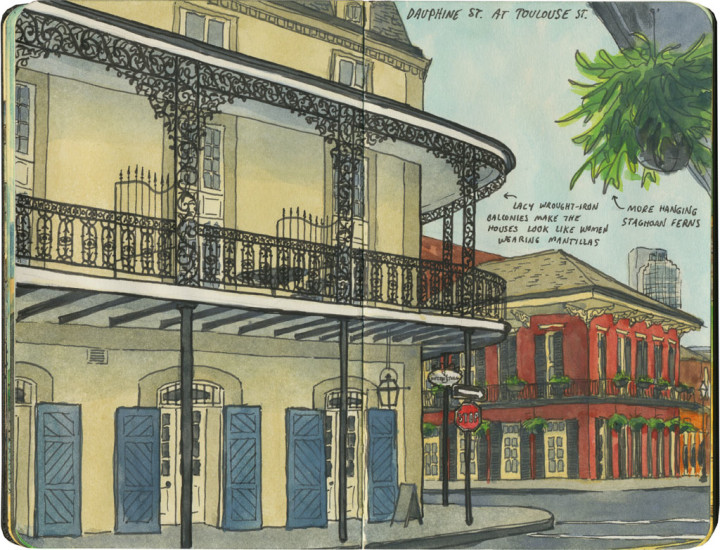
City of lace
Today it seems only fitting to hop from one French city to another. Other than the obvious connotation of the French Quarter, the multi-colored houses also made New Orleans remind me of Montreal. The thing that set NOLA apart, though, was all that stunning wrought iron.
Since they call it the French Quarter, it’s easy to forget that New Orleans is just as influenced by Spain—that Creole culture is just as Spanish as it is French. The city’s wrought-iron balconies brought the lesson home for me. As I rounded every corner, all I could see were houses draped in lacy Spanish mantillas.
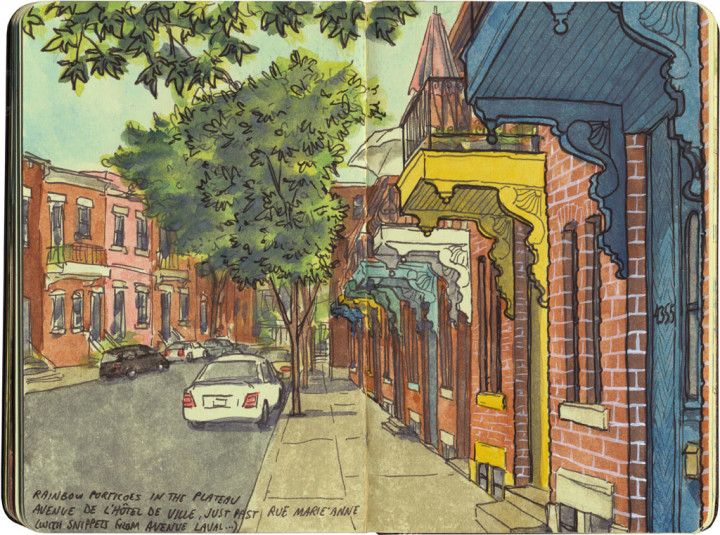
City colors
Sketching the striped tulip fields last week reminded me of one of my other favorite colorful places: the Plateau neighborhood of Montreal. The rows of colorful balconies and porches might not be quite as vivid as the rainbow houses of San Francisco… but any city that breaks up endless blocks of brick with pops of bright color is going to get an A+ in my book.

Mermaid lagoon
A big part of any tourist experience (for me, at least) is catching a glimpse of local wildlife. People go to Yellowstone to see bears and bison. They come to my neck of the woods to spy orcas. When I was in Big Bend, it was all about the javelinas. So you can bet I wasn’t going to take my first trip to Florida without seeing some manatees.
The odd thing is that at this time of year, one of the best places to glimpse a sea cow is not a pristine nature park—but an industrial canal. The Tampa power plant uses the waterway as part of its cooling system, and as a result, cycles heated water back into the canal. The water is up to 20 degrees warmer than the winter temperatures of the adjacent Gulf of Mexico, so it attracts manatees in droves.
The courtesy of a wooden platform perched over the manatee area was lovely—and I was incredibly excited to see so many manatees at once—but I found myself sorely wishing for the kind of underwater windows they have for watching salmon in Seattle. That way, I could see for myself whether sea cows really resemble sea lasses, as the sailors of old thought they did…
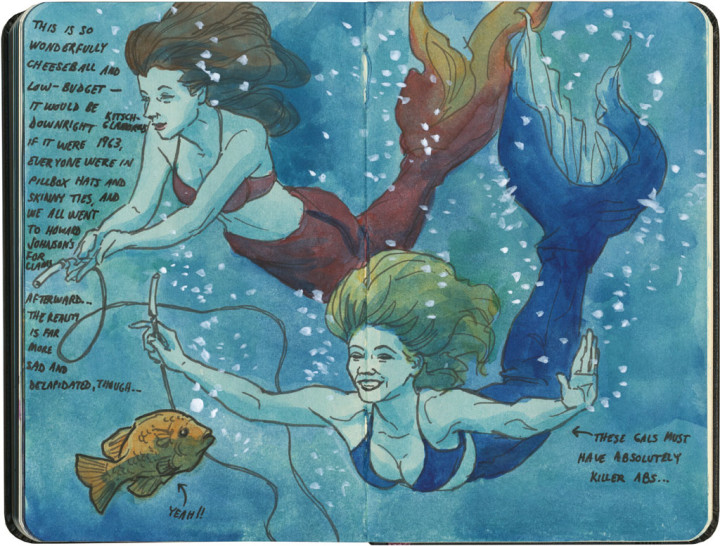
Fishwives
Speaking of underwater sights, if only the Ballard fish ladder had mermaids in it. Good thing I got to visit Weeki Wachee Springs a few weeks ago! Now I’m spoiled—I fear Weeki Wachee may have ruined roadside attractions for me forever. I mean really—no matter how seedy and pathetic a tourist trap might be (and I’m sorry to say there were aspects of this place that were), anything with mermaid performers is an instant winner in my book.
There were two little girls sitting next to me, and when I looked over to add them to my sketch, I had to smile. When I was their age, I was totally into mermaids (I was eight when Disney released its famous fishy juggernaut of a feature)—if I had been to Weeki Wachee at that age, I probably would have thought I’d died and gone to heaven. Even at the ripe old age of 33, it wasn’t hard for me to look past the shabbiness and ho-made production values and find a little mermaid magic to love.

